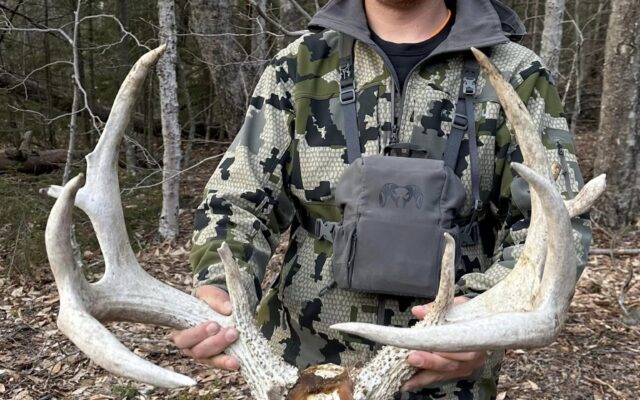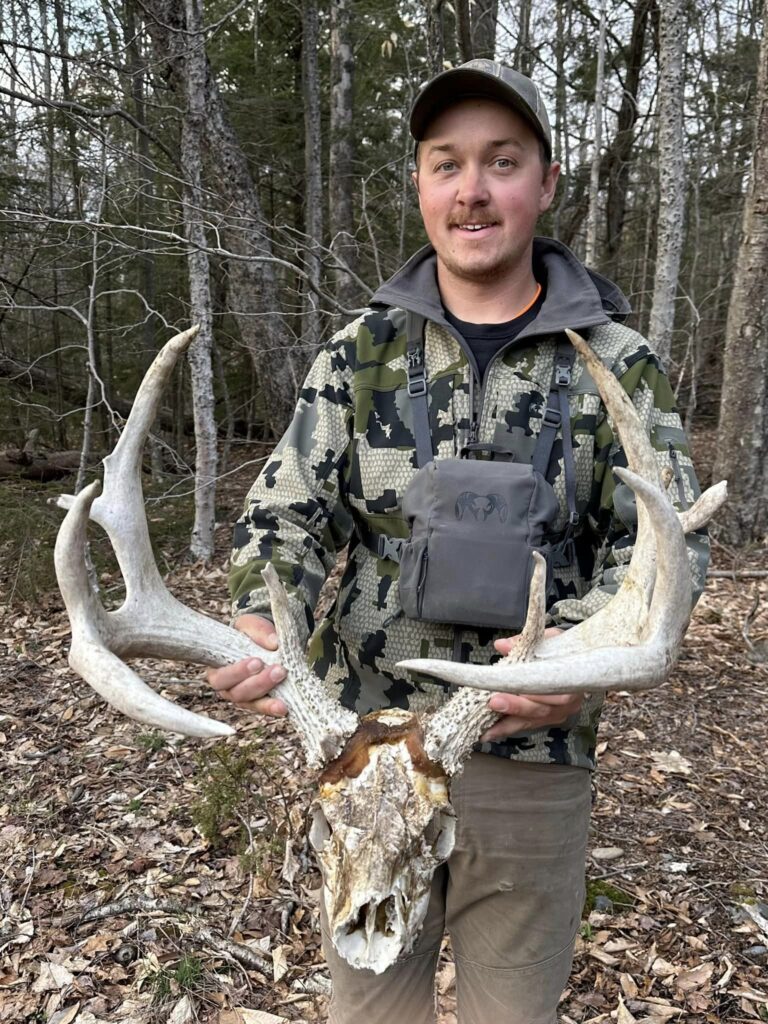
He found a dream buck in the Maine woods. There was just one catch.
By Pete Warner, Bangor Daily News Staff
Garrett Wilbur is an avid deer hunter and enjoys spending time in the woods near his home in Greenville.
In the spring, those forays often center around searching for moose sheds, antlers that have dropped off the heads of bull moose over the winter.
“I’ve been doing it quite a while, since I was a kid,” Wilbur said. “We find some good-looking wintering areas for moose and just meander through and hope for the best.”
On April 20, the Gray native visited a spot where a year ago he had found a matching set of moose sheds. Wilbur likes to collect antlers, and even sold a set for the first time last year.
This year, there were no moose antlers to be found during his return to the spot. Instead, Wilbur stumbled onto something even more intriguing.

DEER SKULL AND ANTLERS — Garrett Wilbur of Greenville holds the skull and antlers from a deer that he discovered on April 20 while searching for moose antler sheds near Greenville.
There on the ground was a so-called deadhead, the skull and antlers of a deer. Two of the tines appeared to have been embedded in the dirt for a while. All that remained of the animal were the antlers, the top of the skull and one neck vertebra. There was little hair and flesh left on the skull.
“It’s definitely the coolest thing I’ve ever found, for sure, just because of the size and the uniqueness of it,” said Wilbur, who did not take the time to search the area more thoroughly for other signs of the deer.
“I was absolutely not expecting to ever stumble across something like that,” he said.
And so the questions began: How did the deer die? How big was it? How did its head wind up in that spot, separated from the rest of the skeleton?
“The story of what happened to it is still a mystery,” Wilbur said.
It’s possible that coyotes or another carnivore may have come upon the carcass and moved it. Wilbur said he has previously come upon scattered animal bones in the woods.
“It must have been dragged a little ways to where it was,” Wilbur said.
What we do know about the deer is that it sported an impressive set of antlers. It’s a mainframe eight-pointer, but there are 13 points total.
Wilbur, who isn’t a trained Boone and Crockett scorer, measured the antlers at approximately 167 inches.
“Everything about it is unique and cool,” he said.
Based on the appearance of the antlers, the deer once attached to them likely was a good one.
“Incredible buck,” said Nathan Bieber, deer biologist for the Maine Department of Inland Fisheries and Wildlife.
“At that size, I have to assume his rack was near peak,” Bieber said. “Buck rack size begins to decline later in life, so I don’t think he was on that downslope yet.”
Bieber said that given the apparent health of the antlers, the lack of velvet and that they were still attached to the deer when it died, some inferences can be drawn.
“That narrows down the time of death a bit to mid-fall through mid-winter,” Bieber said.
He said collared deer studied by the state, which die of poor body condition or malnutrition, often succumb in April. The deer in question typically would have shed its antlers by then, so that doesn’t seem likely.
What else might have killed the buck?
“Some possibilities would be rut [mating season] injury or hunting injury leading to a death — or predation,” Bieber said.
However, he suspects this particular buck, given its likely age, if healthy would have presented a challenge to four-legged predators.
If a hunter had the chance to shoot at the buck, they obviously never found it. That would have been agonizing for most hunters.
Ultimately, there is no way to know precisely how a seemingly healthy mature buck died and lost its head.
“It’s all conjecture, of course, but fun to try and imagine how his life may have unfolded,” Bieber said.
Wilbur has achieved some success of his own as a hunter, shooting a 214-pound buck in the region in 2018. He hopes to turn the discovery of the deadhead into another lasting memory.
“I’ll honestly probably just boil it down, clean it up and maybe darken the antlers back up a little bit just to give it some character so it can be hung on the wall,” Wilbur said.